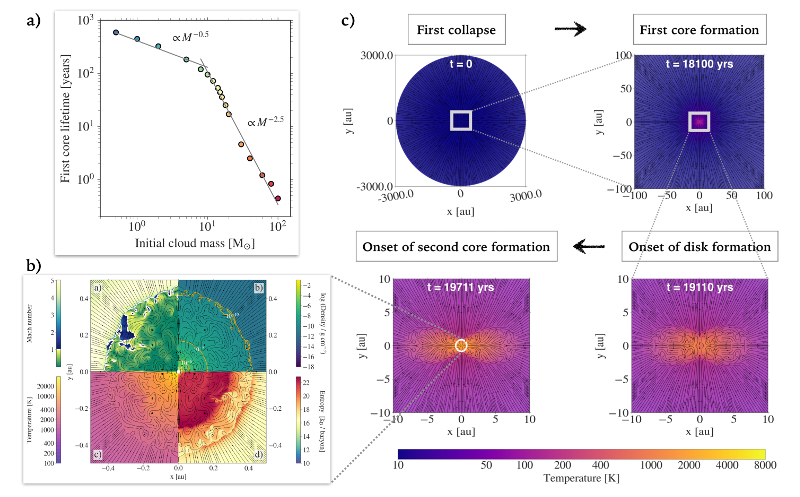| EPoS Contribution |
|
Zooming in on star and disk formation
Asmita Bhandare MPIA, Heidelberg, DE | |
| Magnetized, cold, dense molecular cloud cores provide the birth environment for stars and disks. This work is aimed at understanding the multi-scale scenario of star formation, which occurs via the formation of two quasi-hydrostatic Larson cores. We perform spherically symmetric, isolated, molecular cloud collapse simulations using the radiation (magneto)hydrodynamic code PLUTO as a tool. These one-dimensional studies, spanning 7 orders of magnitude in spatial scales, account for the phase transitions by using a realistic gas equation of state via a density- and temperature-dependent adiabatic index and mean molecular weight. For the first time, a large parameter scan across initial low- to high-mass (0.5 Msun - 100 Msun) molecular cloud cores is surveyed. In this talk, I will highlight the dependence of the first and second hydrostatic core properties on the initial cloud properties. The results indicate that in the high-mass regime, first hydrostatic cores do not have time to evolve because of the large accretion rates. Following these results, we have investigated the evolution of the second hydrostatic core using two-dimensional radiation hydrodynamic collapse simulations with a resolution that has not been achieved before. These studies demonstrate, for the first time, the onset of convection within the second core for the collapse cases of non-rotating molecular cloud cores in the low-mass regime. This supports an interesting possibility that dynamo-driven magnetic fields may be generated during the very early phases of low-mass star formation. Additionally, I will also discuss the impact of different cloud properties on the formation and evolution of circumstellar disks, formed due to the conservation of angular momentum. | |
 | |
| Caption: a) First core lifetime, i.e., time between the onset of formation of the first and second cores for different initial cloud masses indicating that first cores are almost non-existent in the high-mass regime. b) Two-dimensional view showing the Mach number, density, temperature and entropy within the second hydrostatic core, which is formed during the collapse of a non-rotating molecular cloud core. c) Two-dimensional temperature snapshots showing different spatial scales from top left to bottom left, as the collapse of a rotating molecular cloud core proceeds through stages of first core (~4 au), disk (~8 au) and second core (~0.4 au) formation. Both RHD simulation results in (b) and (c) show the evolution of a 1 Msun molecular cloud core with an initial temperature of 10 K and initial radius of 3000 au. The velocity streamlines in black indicate the in-falling material and mixing within the second core and disk. | |
| Collaborators: Kuiper R., IAAT, DE Henning Th., MPIA, DE Fendt C., MPIA, DE Flock M., MPIA, DE Marleau G. D., IAAT, DE |
Key publication
Suggested Session: Cores2Disks |

